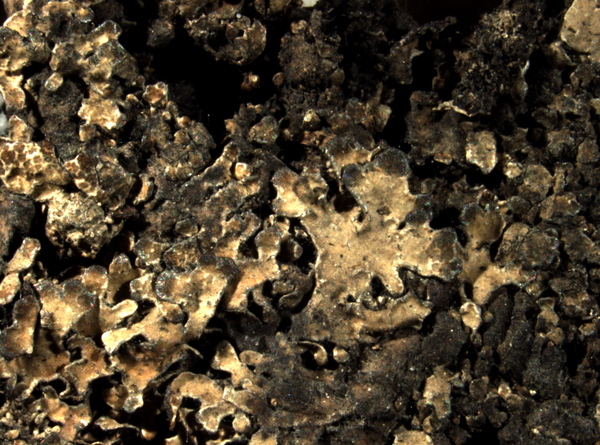Parmelia pinnatifida Kurok.
J. Jap. Bot. 51, 12: 378, 1976
Synonyms: Parmelia omphalodes subsp. pinnatifida (Kurok.) Skult,
Description: Thallus foliose, heteromerous, dorsiventral, rather loosely attached, forming more or less regular, up to 10 cm wide rosettes, which often merge into extensive swards. Lobes 1(-2) mm wide, but mostly <1.5 mm wide, short and branched, with angular apices, often imbricate, the margins often with up to 0.3 mm wide, ascending to erect lobules. Upper surface usually blackish, rarely grey to brown in shade-forms, slightly shiny, epruinose, with mainly marginal, whitish, at first punctiform but soon linear and furcate pseudocyphellae which sometimes merge forming a white marginal rim; lower surface black, with simple or forked, black rhizines that are most abundant towards the margin. Upper cortex paraplectenchymatous, of 2-6 layers of densely packed cells, with a usually non-pored epicortex, the cell walls with isolichenan; medulla white; algal layer continuous; lower cortex paraplectenchymatous, thinner than upper cortex. Apothecia rare, lecanorine, cup-shaped, to 4 mm across, with a dark brown, often splitting disc and a prominent thalline margin. Epithecium brownish; hymenium and hypothecium colourless. Asci 8-spored, clavate, Lecanora-type. Ascospores 1-celled, hyaline, ellipsoid, 10-15 x 7-9 µm. Pycnidia black, common, laminal. Conidia more or less thickened at both ends, 5.5-6.5 x c. 1 µm. Photobiont chlorococcoid. Spot tests: upper cortex K+ yellow (but often slowly turning dirty red due to medullary substances), C-, KC-, P- or P+ faintly yellow; medulla K+ yellow turning dirty red, C-, KC-, P+ orange-red. Chemistry: upper cortex with atranorin; medulla with consalazinic and salazinic acids (major), and variable amounts of galbinic, fumarprotocetraric and lobaric acids (accessory or in traces).
Growth form: Foliose
Substrata: rocks
Photobiont: green algae other than Trentepohlia
Reproductive strategy: mainly sexual
Commonnes-rarity: (info)
Alpine belt: rare
Subalpine belt: rare
Montane belt: absent
Dry submediterranean belt: absent
Humid submediterranean belt: absent
Padanian area: absent
pH of the substrata:
1 2 3 4 5
Solar irradiation:
1 2 3 4 5
Aridity:
1 2 3 4 5
Eutrophication:
1 2 3 4 5
Poleotolerance:
0 1 2 3
Altitudinal distribution:
1 2 3 4 5 6
Rarity
absent
extremely rare
very rare
rare
rather rare
rather common
common
very common
extremely common
Loading data...
Occurrence data
Predictive map
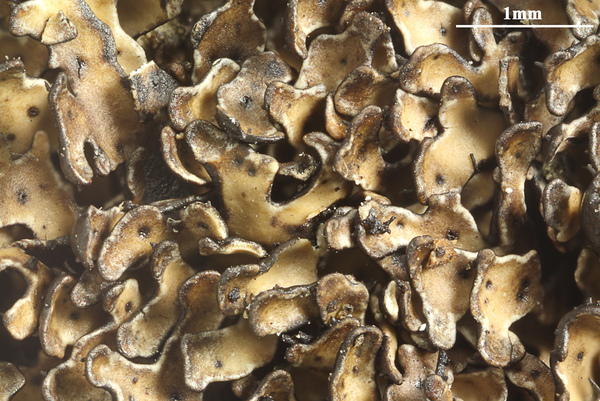
Felix Schumm - CC BY-SA 4.0
[3209], Schweiz, Davos, nordöstlich des Flüela Paß bei Tschuggen, Hanglage W-Exposition, Gneisschiefer, ca. 1940 m. Leg. F. Schumm & Hans-J. Maier 22.09.1974, det. F. Schumm 2019.
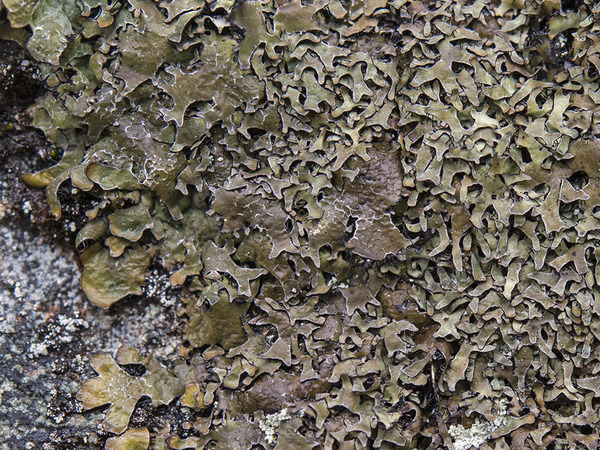
Cor Zonneveld
Eresfjord (Møre og Romsdal), Norway
18.07.2016
Source: https://corzonneveld.nl/fungi/lichens/Lecanoromycetes/Lecanorales/Parmeliaceae/Parmelia/pinnatifida.php
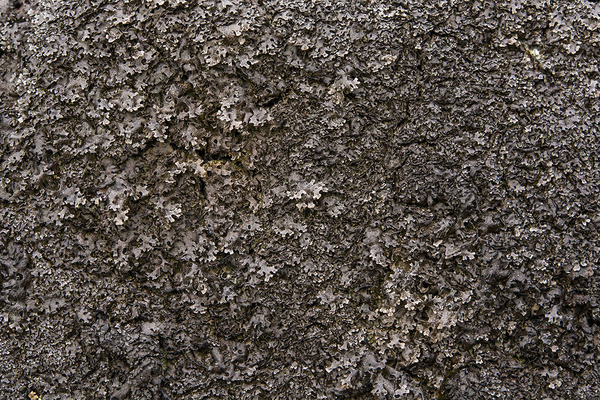
Cor Zonneveld
Trollstigen (Møre og Romsdal), Norway
22.07.2016
Source: https://corzonneveld.nl/fungi/lichens/Lecanoromycetes/Lecanorales/Parmeliaceae/Parmelia/pinnatifida.php
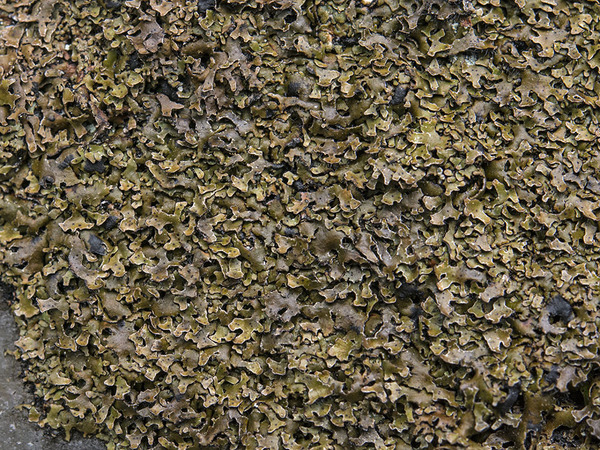
Cor Zonneveld
Evanger (Hordaland), Norway
28.07.2016
Source: https://corzonneveld.nl/fungi/lichens/Lecanoromycetes/Lecanorales/Parmeliaceae/Parmelia/pinnatifida.php
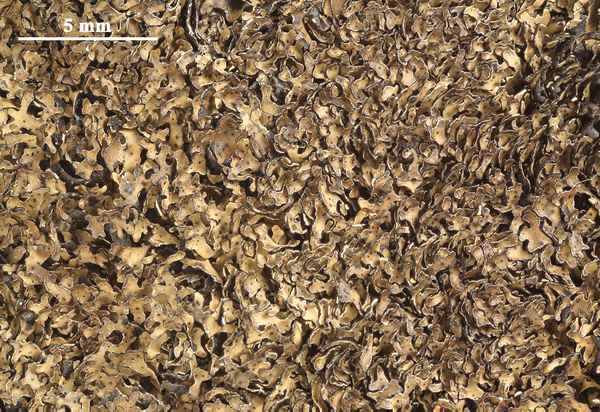
Felix Schumm - CC BY-SA 4.0
[3209], Schweiz, Davos, nordöstlich des Flüela Paß bei Tschuggen, Hanglage W-Exposition, Gneisschiefer, ca. 1940 m. Leg. F. Schumm & Hans-J. Maier 22.09.1974, det. F. Schumm 2019.
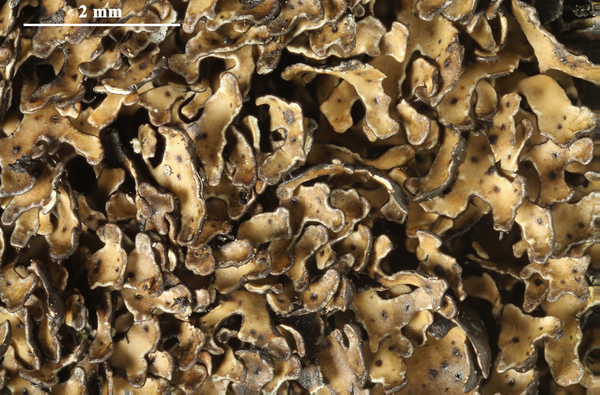
Felix Schumm - CC BY-SA 4.0
[3209], Schweiz, Davos, nordöstlich des Flüela Paß bei Tschuggen, Hanglage W-Exposition, Gneisschiefer, ca. 1940 m. Leg. F. Schumm & Hans-J. Maier 22.09.1974, det. F. Schumm 2019.
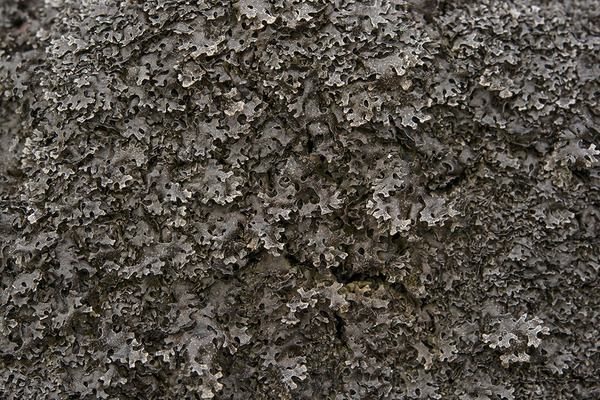
Cor Zonneveld
Trollstigen (Møre og Romsdal), Norway
22.07.2016
Source: https://corzonneveld.nl/fungi/lichens/Lecanoromycetes/Lecanorales/Parmeliaceae/Parmelia/pinnatifida.php
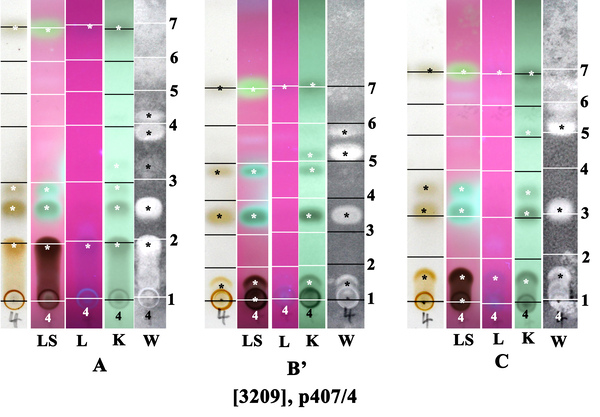
Felix Schumm - CC BY-SA 4.0
[3209], Schweiz, Davos, nordöstlich des Flüela Paß bei Tschuggen, Hanglage W-Exposition, Gneisschiefer, ca. 1940 m. Leg. F. Schumm & Hans-J. Maier 22.09.1974, det. F. Schumm 2019.
at: atranorin, sa: salazinic acid, csa: consalazinic acid, li: lichesterinic
acid, pl: protolichsterinic acid, a: gyrophoric acid ?, b: umbilicaric
acid ?
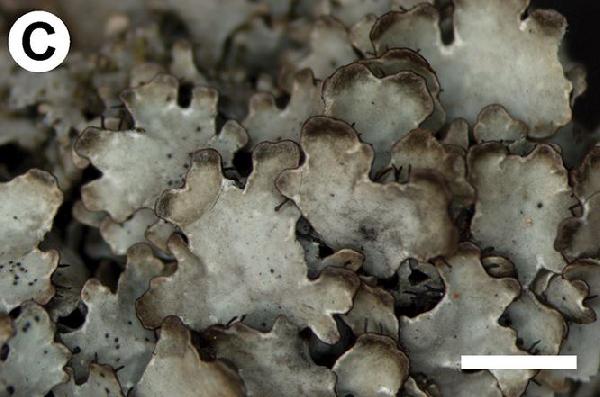
Source:Ossowska E, Guzow-Krzemińska B, Kolanowska M, Szczepańska K, Kukwa M (2019) Morphology and secondary chemistry in species recognition of Parmelia omphalodes group – evidence from molecular data with notes on the ecological niche modelling and genetic variability of photobionts. MycoKeys 61: 39-74. - CC BY-4.0
C P. pinnatifida, with marginal pseudocyphellae (UGDA L-24298)
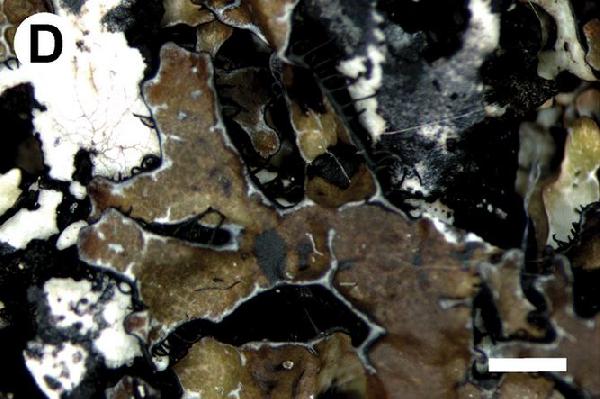
Source:Ossowska E, Guzow-Krzemińska B, Kolanowska M, Szczepańska K, Kukwa M (2019) Morphology and secondary chemistry in species recognition of Parmelia omphalodes group – evidence from molecular data with notes on the ecological niche modelling and genetic variability of photobionts. MycoKeys 61: 39-74. - CC BY-4.0
D P. pinnatifida, with marginal and laminal pseudocyphellae, laminal pseudocyphellae starting predominantly from pseudocyphellae formed at the edge of lobes (S F-239397). Scale bar: 200 μm
Growth form: Foliose
Substrata: rocks
Photobiont: green algae other than Trentepohlia
Reproductive strategy: mainly sexual
Commonnes-rarity: (info)
Alpine belt: rare
Subalpine belt: rare
Montane belt: absent
Dry submediterranean belt: absent
Humid submediterranean belt: absent
Padanian area: absent
pH of the substrata:
| 1 | 2 | 3 | 4 | 5 |
Solar irradiation:
| 1 | 2 | 3 | 4 | 5 |
Aridity:
| 1 | 2 | 3 | 4 | 5 |
Eutrophication:
| 1 | 2 | 3 | 4 | 5 |
Poleotolerance:
| 0 | 1 | 2 | 3 |
Altitudinal distribution:
| 1 | 2 | 3 | 4 | 5 | 6 |
Rarity
absent
extremely rare
very rare
rare
rather rare
rather common
common
very common
extremely common
Loading data...
Occurrence data
Predictive map

Felix Schumm - CC BY-SA 4.0
[3209], Schweiz, Davos, nordöstlich des Flüela Paß bei Tschuggen, Hanglage W-Exposition, Gneisschiefer, ca. 1940 m. Leg. F. Schumm & Hans-J. Maier 22.09.1974, det. F. Schumm 2019.

Cor Zonneveld
Eresfjord (Møre og Romsdal), Norway
18.07.2016
Source: https://corzonneveld.nl/fungi/lichens/Lecanoromycetes/Lecanorales/Parmeliaceae/Parmelia/pinnatifida.php

Cor Zonneveld
Trollstigen (Møre og Romsdal), Norway
22.07.2016
Source: https://corzonneveld.nl/fungi/lichens/Lecanoromycetes/Lecanorales/Parmeliaceae/Parmelia/pinnatifida.php

Cor Zonneveld
Evanger (Hordaland), Norway
28.07.2016
Source: https://corzonneveld.nl/fungi/lichens/Lecanoromycetes/Lecanorales/Parmeliaceae/Parmelia/pinnatifida.php

Felix Schumm - CC BY-SA 4.0
[3209], Schweiz, Davos, nordöstlich des Flüela Paß bei Tschuggen, Hanglage W-Exposition, Gneisschiefer, ca. 1940 m. Leg. F. Schumm & Hans-J. Maier 22.09.1974, det. F. Schumm 2019.

Felix Schumm - CC BY-SA 4.0
[3209], Schweiz, Davos, nordöstlich des Flüela Paß bei Tschuggen, Hanglage W-Exposition, Gneisschiefer, ca. 1940 m. Leg. F. Schumm & Hans-J. Maier 22.09.1974, det. F. Schumm 2019.

Cor Zonneveld
Trollstigen (Møre og Romsdal), Norway
22.07.2016
Source: https://corzonneveld.nl/fungi/lichens/Lecanoromycetes/Lecanorales/Parmeliaceae/Parmelia/pinnatifida.php

Felix Schumm - CC BY-SA 4.0
[3209], Schweiz, Davos, nordöstlich des Flüela Paß bei Tschuggen, Hanglage W-Exposition, Gneisschiefer, ca. 1940 m. Leg. F. Schumm & Hans-J. Maier 22.09.1974, det. F. Schumm 2019.
at: atranorin, sa: salazinic acid, csa: consalazinic acid, li: lichesterinic
acid, pl: protolichsterinic acid, a: gyrophoric acid ?, b: umbilicaric
acid ?

Source:Ossowska E, Guzow-Krzemińska B, Kolanowska M, Szczepańska K, Kukwa M (2019) Morphology and secondary chemistry in species recognition of Parmelia omphalodes group – evidence from molecular data with notes on the ecological niche modelling and genetic variability of photobionts. MycoKeys 61: 39-74. - CC BY-4.0
C P. pinnatifida, with marginal pseudocyphellae (UGDA L-24298)



